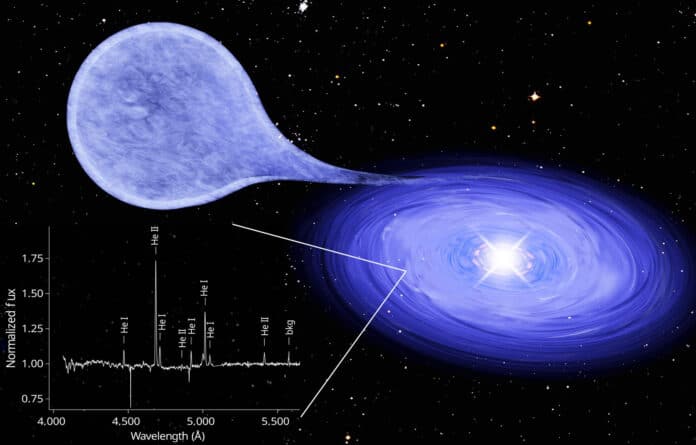However, despite years of diligent study, it is still unknown under what conditions a white dwarf’s mass can increase to the Chandrasekhar limit. The Indian-American scientist and Nobel laureate Subrahmanyan Chandrasekhar established this as the theoretical upper limit for the mass of a white dwarf in 1930.
Supersoft X-ray sources with stable hydrogen burning on their surfaces were discovered as a new class of objects using ROSAT in the early 1990s. For a while, those objects were thought to be candidates for SN Ia progenitors. The issue with these sources is their quantity of hydrogen, while type Ia supernovae exhibit no sign of hydrogen.
Double star systems with white dwarfs that steadily accrete and burn helium at their surfaces have been anticipated for over 30 years, but these sources have never been seen. The Max Planck Institute for Extraterrestrial Physics (MPE) has led a global team in discovering an X-ray source whose optical spectra are entirely dominated by helium.
The team has found a binary star system in which matter flows onto the white dwarf from its companion. Bright, so-called supersoft X-rays that result from the nuclear fusion of the spilled gas close to the white dwarf’s surface led to the discovery of the system. The peculiarity of this source is the overflow and burning of helium rather than hydrogen.
It may be easier to comprehend the number of supernovae brought on by exploding white dwarfs if the mass of the white dwarf is rising more slowly than was previously considered to be conceivable, according to the measured luminosity.
Jochen Greiner, who leads the analysis of this source at MPE, said, “The supersoft X-ray source [HP99] 159 has been known since the 1990s, when it was first observed with ROSAT, more recently with XMM-Newton and now with eROSITA. Now, we can identify it as an optical source in the Large Magellanic Cloud. In its spectrum, we found mainly emission lines of helium originating from the accretion disk.”
Prof. Dr. Norbert Langer of the Argelander Institute for Astronomy, who is also a member of the Matter Transdisciplinary Research Area at the University of Bonn, said, “The observed X-ray brightness suggests that the burning of the inflowing helium in the white dwarf is stabilized by its rapid rotation, making a final supernova explosion of the system likely.”
Julia Bodensteiner of ESO, who has been studying massive stars since her master’s thesis at MPE, said, “Stars without hydrogen envelopes, such as the companion star found in [HP99] 159, are an important intermediate step in the life cycle of binary stars that should occur in about 30% of such systems.”
“There should be many such stars, but only a few have been observed so far.”
Journal Reference:
- J. Greiner et al., A helium-burning white dwarf binary as a supersoft X-ray source, Nature (2023). DOI: 10.1038/s41586-023-05714-4
